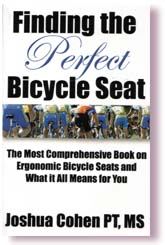[ 63XC.COM | REVIEWS | PERFECT SEAT ]
Joshua Cohen: 'Finding The Perfect Bicycle Seat'
The response that piece received was one of the first indications that 63xc.com had reached an audience beyond our core group of hairy backwoodsmen. It got us namechecked widely, both on the web and in print. We were asked for State Of The Industry comments by a couple of survey groups. And we got a serious enquiry from a potential advertiser (who pulled out PDQ, presumably after reading the review right through to the end). Eighteen months down the line, things have settled down rather, but we still get occasional bits of fallout. One of the most recent was a fat A5 envelope from a US address. Inside it was a copy of a book written by Joshua Cohen and published by RoadBikeRider.com. Would we like to review it? Sure! 'Finding The Perfect Bicycle Seat' is really a pamphlet or extended essay rather than a proper book -- 70-odd pages of large text. Then again, size isn't everything, as the actress said to the bishop. Cohen did a master's thesis on bike saddles and their relationship to the body, and runs a 'biomechanical bicycle and multisport evaluation' business. It shows. He really knows his stuff. He manages to pass on a healthy dollop of that knowledge, too. On the basis that you need to know how things go right before you can understand how they go wrong, he dedicates perhaps a quarter of the book to a detailed account of the male anatomy and its healthy function. Another quarter goes on discussion of possible failure modes, the physiology of which turns out more complex and elusive than you might expect. Around this point, the text begins to fill with references to previous cycling / disfunction studies, and Cohen gets into discussion of experimental method. This is his unique selling proposition, and he's entitled to crow about it. Past work on the interaction between genitals and saddles have been compromised by experimental difficulties. After all, how would you fancy riding a training bike while someone drew blood from your dick every 30 seconds? Cohen, however, is into something called transcutaneous oxygen pressure measurement which allows him to analyse blood flow without sticking needles into his subjects' tender areas. Hot tuna! Cohen's approach isn't perfect. The most glaring flaw -- about which he is completely upfront -- is that TCOP measurement is presently a guy thing, due to non-negotiable differences in plumbing. As a result, women readers may feel a bit left out. A less obvious problem is the fact that his experimental method disposes him to discuss impotence primarily in terms of circulation, with much less emphasis on neurology. To be fair to Cohen, however, he does point out that penile nerves and blood vessels share lodging space in a structure called -- fnaar! -- Alcock's canal, and that what is good for one is likely to be good for the other. So, what is good for those nerves and blood vessels, exactly? And what is bad? Probably the single most striking single datum in the book is an independent confirmation of the Sommer and Fröbose findings from the Bicycle Saddle Report: a modern, stretched-out aero position wrecks your genital blood flow. Cohen, however, is a competitive cyclist, and unlike Sommer he knows better than to try to sell his contemporaries on keeping their upper body at 60° to the horizontal. Instead, he looks at saddle designs that can minimise the damage. Probably the most distinctive feature of his approach is an emphasis on the ischial tuberosities or 'sit bones': he even has a method with diagrams for measuring the spacing of your own set, and hence choosing an appropriately supportive saddle. Plus, if you absolutely must put weight on your soft tissues, you'll likely want to do so on a saddle set up the way Cohen recommends. He even discusses fore-aft positioning and tilt. All this leads up to Cohen's own distinctive saddle design. Once again, his experience as a cyclist shows through: he doesn't try to sell you two globular cushions in a gel sac or suchlike. The Cohen saddle has a long nose, a distinctive 'winged' rear, and a sharper-than-usual transition between the two zones. It's clearly do-able using contemporary manufacturing techniques and, more to the point, it looks like it belongs on a racing bike. I'd buy one myself, if the wear patterns on my much-loved 60s Brooks Comp didn't resemble the Cohen prescription so closely. I hope Josh gets his saddle to market and makes a million. Meanwhile, if you're a guy and you've ever worried about whether your sport might be responsible for any decrease in your joie-de-vivre, you might want to read his book.
[ TOP ] |
Writer
Will Meister is a lifelong cyclist. He claims that this has not affected his joie de vivre.
Date
v1.0 written January 2005
Related
Joshua Cohen's excellent book is ISBN 0971 461 929 and is available direct from Road Bike Rider at US$17.95. There's a cheaper e-book version, too.
63xc.com's review of the 2003 Bicycle Saddle Report is here.
Mailing list
Join the 63xc.com list.
 Back in 2003, 63xc.com was one of only a handful of English-language publications to review a pan-European CD-ROM published under the title 'The Bicycle Saddle Report'. We discussed the report carefully, relaying its findings about possible links between cycling and sexual problems, considering the practicality of the solutions it offered, and chiding gently certain apparent failures of objectivity on the part of its editors.
Back in 2003, 63xc.com was one of only a handful of English-language publications to review a pan-European CD-ROM published under the title 'The Bicycle Saddle Report'. We discussed the report carefully, relaying its findings about possible links between cycling and sexual problems, considering the practicality of the solutions it offered, and chiding gently certain apparent failures of objectivity on the part of its editors.